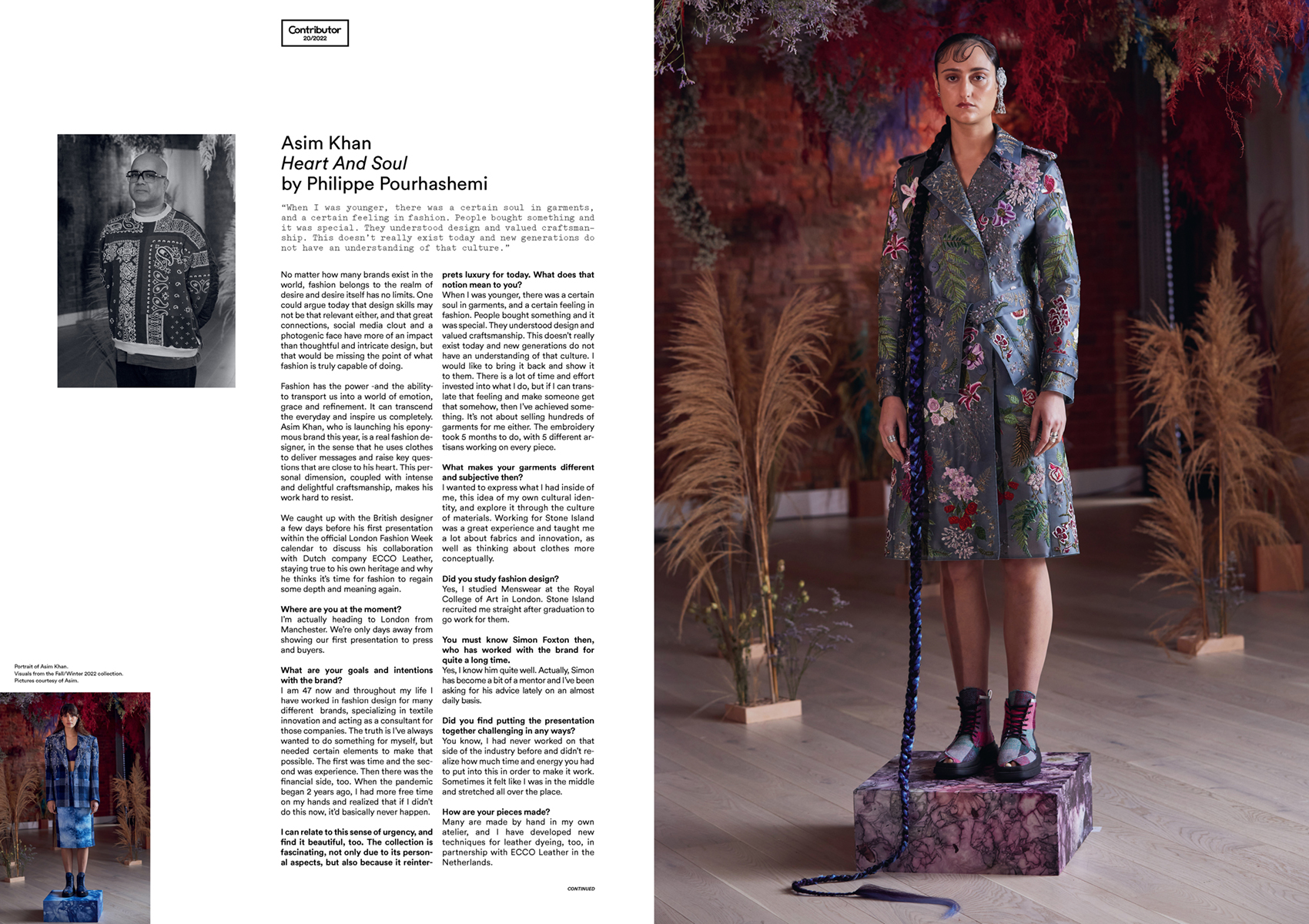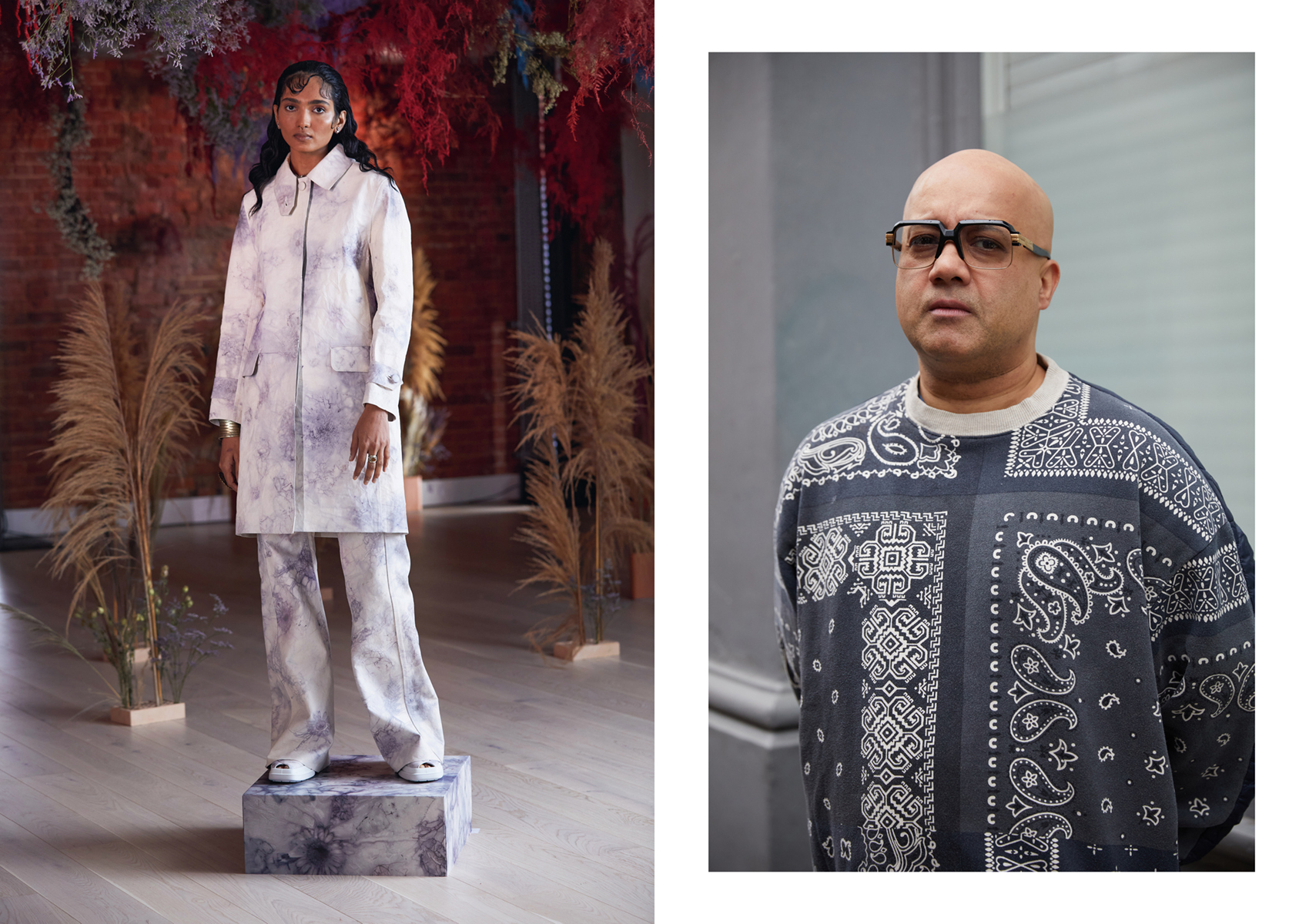
Heart and Soul. Interview with Asim Khan
By Philippe Pourhashemi
No matter how many brands exist in the world, fashion belongs to the realm of desire and desire itself has no limits. One could argue today that design skills may not be that relevant either, and that great connections, social media clout and a photogenic face have more of an impact than thoughtful and intricate design, but that would be missing the point of what fashion is truly capable of doing.
Fashion has the power – and the ability – to transport us into a world of emotion, grace and refinement. It can transcend the everyday and inspire us completely. Asim Khan, who is launching his eponymous brand this year, is a real fashion designer, in the sense that he uses clothes to deliver messages and raise key questions that are close to his heart. This personal dimension, coupled with intense and delightful craftsmanship, makes his work hard to resist.
We caught up with the British designer a few days before his first presentation within the official London Fashion Week calendar to discuss his collaboration with Dutch company ECCO Leather, staying true to his own heritage and why he thinks it’s time for fashion to regain some depth and meaning again.
Where are you at the moment?
I’m actually heading to London from Manchester. We’re only days away from showing our first presentation to press and buyers.
What are your goals and intentions with the brand?
I am 47 now and throughout my life I have worked in fashion design for many different brands, specializing in textile innovation and acting as a consultant for those companies. The truth is I’ve always wanted to do something for myself, but needed certain elements to make that possible. The first was time and the second was experience. Then there was the financial side, too. When the pandemic began two years ago, I had more free time on my hands and realized that if I didn’t do this now, it’d basically never happen.
I can relate to this sense of urgency, and find it beautiful, too. The collection is fascinating, not only due to its personal aspects, but also because it reinterprets luxury for today. What does that notion mean to you?
When I was younger, there was a certain soul in garments, and a certain feeling in fashion. People bought something and it was special. They understood design and valued craftsmanship. This doesn’t really exist today and new generations do not have an understanding of that culture. I would like to bring it back and show it to them. There is a lot of time and effort invested into what I do, but if I can translate that feeling and make someone get that somehow, then I’ve achieved something. It’s not about selling hundreds of garments for me either. The embroidery took 5 months to do, with 5 different artisans working on every piece.
What makes your garments different and subjective then?
I wanted to express what I had inside of me, this idea of my own cultural identity, and explore it through the culture of materials. Working for Stone Island was a great experience and taught me a lot about fabrics and innovation, as well as thinking about clothes more conceptually.
Did you study fashion design?
Yes, I studied Menswear at the Royal College of Art in London. Stone Island recruited me straight after graduation to go work for them.

You must know Simon Foxton then, who has worked with the brand for quite a long time.
Yes, I know him quite well. Actually, Simon has become a bit of a mentor and I’ve been asking for his advice lately on an almost daily basis.
Did you find putting the presentation together challenging in any ways?
You know, I had never worked on that side of the industry before and didn’t realize how much time and energy you had to put into this in order to make it work. Sometimes it felt like I was in the middle and stretched all over the place.
How are your pieces made?
Many are made by hand in my own atelier, and I have developed new techniques for leather dyeing, too, in partnership with ECCO Leather in the Netherlands.
Can you talk about these new treatments?
Four years ago, ECCO Leather asked me to do a workshop for them and involve Stone Island. We ended up doing several projects together and from there they asked me to come on as a consultant. Then I started to think about this idea of printing leather with flower dyeing and they wanted to support me on this. Flower dyeing on leather hadn’t been explored beforehand, because if you want to do it in a natural way, it’s actually quite difficult. I spotted a technique in India and another one in Japan, which I sort of mixed together in order to create a new one using natural ingredients.
How long did it take to develop this technique?
It took two years. The leather we use is transparent leather, which is achieved by freezing the moment it becomes this way. Together with ECCO, we managed to develop a technique that prevents the bacterial process from taking place. We found a way to fix it and keep the hides transparent. We dyed them and sent them to my wife’s studio in Pakistan, where the pieces were embroidered by hand.
That is amazing. Is the whole debut collection made in leather?
Yes. I have five projects in mind for the brand and each project is focused on a specific material. The first one is about leather craftsmanship, but later I’m keen on exploring possibilities with Harris tweed, Indian handwoven cotton or recycled silk from Pakistan. It’s all about bringing these cultural differences together and literally bonding them within the clothes. They are used in conjunction to achieve something unique.

You decided to opt for the presentation format to introduce your brand. Can you tell us why?
I think I wanted something immersive and a presentation allows you to achieve that. People can come in and spend the time they want to in order to understand the work. I’m also keen on sharing the techniques openly with my audience. I’m not a designer who tries to hide his process either and we will be using film in order to document key creative steps. The presentation is actually followed by an exhibition, which allows people to come later and discover the collection in their own time.
What are your thoughts on the industry today?
I’m so sick of everything that’s been going on in fashion lately. I wanted to design something that had soul and felt meaningful to me. I do this work, because I want to create feelings and emotions. I need to express myself freely, and get people to understand what it’s like to hold a well-made garment in your hand.
What about the cultural aspects and drawing upon your own roots?
I was born in Britain, and there were many different subcultures out there in 1980s England. I guess there was this shock and huge contrast between my life at home with my family and what was happening in the outside world. My parents kept teaching me about my culture and it was important for them to educate me that way. As we grow older, we start realizing we have this third culture, a combination of the two if you wish. My collection is keen on exploring this middle ground and I’m not interested in replicating certain motifs or techniques. I want to reinterpret them to make them new and relevant.
Do you have any key memories from your childhood that illustrate this idea of a third culture?
When I was eight years old, my grandfather passed away and we flew to Pakistan. We were supposed to stay two weeks and I ended up staying there for four years and going to school in Pakistan from the age of eight to twelve. Culture has always been important to me that way. And garments are a way to express that, too.
Asim Khan is a British designer who graduated from the Royal College of Art in London. He has worked for Stone Island and other prominent brands, focusing on textile development and fabric consultancy. This season, Khan launched his eponymous brand within the official calendar of London Fashion Week. His clothes explore the ideas of culture and craftsmanship through the lens of his own storytelling. His brand has its own Instagram, named asimkhan and www.3rdmigration.com is his website.
A fashion writer, consultant and stylist, Philippe Pourhashemi was born in Tehran and grew up in Paris. In 2005, he graduated with a PhD in Cultural Studies. Working as a freelance coach for several brands in Belgium, Germany, Switzerland, Holland and Kazakhstan, Philippe advises designers who sell their collections internationally.
